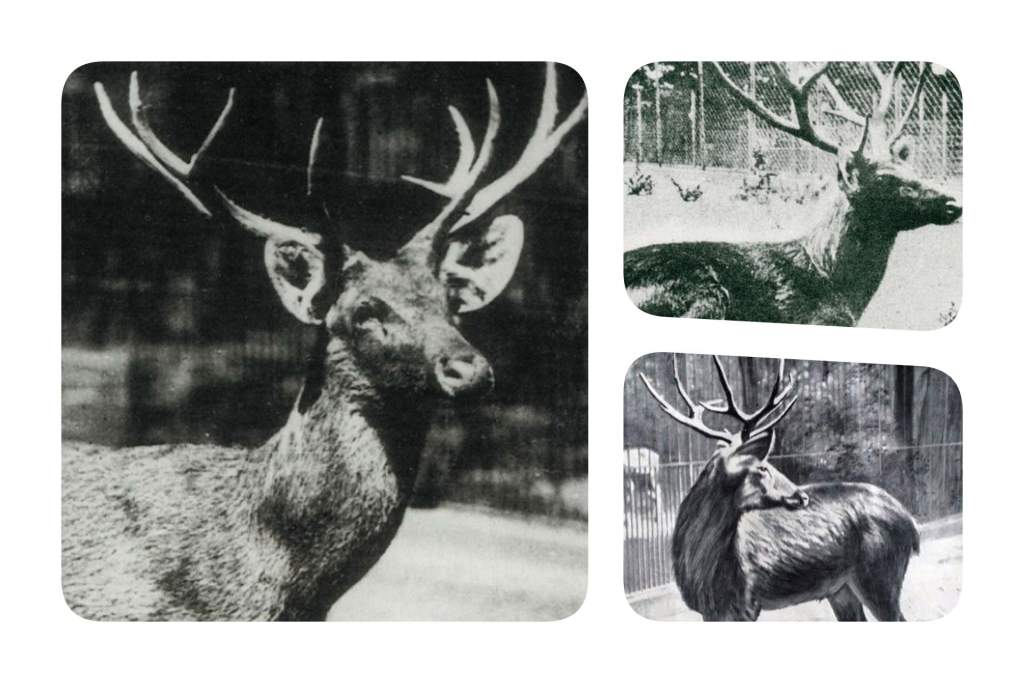Despite being once common, Schomburgk’s Deer (Rucervus schomburgki) is a mysterious extinct animal. Currently, there is only one preserved specimen in the world’s museums, a stuffed animal in the Natural History Museum in Paris. Similarly, there appears to be only one photograph, taken at a Berlin zoo during 1911 (another purporting to show Schomburgk’s deer may actually be another species).
It is estimated that no more than seven individuals have been kept in zoos in Europe, whereas none have been seen in North America. It is unknown if a European has ever seen a living example in Thailand – the species’ stronghold – or anywhere else in southeast Asia. Yet, there are likely to be 400 antlers still preserved in museums or in private collections.
In the past, such antlers played an important role in the Chinese pharmaceutical trade. Schomburgk’s deer could be found in swampy plains of long grass, cane, and shrubs throughout central Thailand, particularly in the Chao Phraya River valley near Bangkok.

Their best-surviving specimens show that they had many points and were elaborately branched. The species was described in 1863 and named after Sir Robert Schomburg, the British consul in Bangkok at the time. Most often found in Thailand, but possibly in neighboring countries as well, it lives in swampy plains with long grass and bamboo.
Schomburgk’s Deer avoided dense vegetation but were abundant in their favorite spots. Approximately one meter in height (3.5 feet), with chocolate-brown coloring and spectacular antlers, they are highly sought after by hunters. The barasingha (R. duvaucelii) was a nearly identical species, also graceful in appearance.
When floods occurred, the small herds in which the animals generally lived were often forced up to higher ground. Sometimes these high points could be easily surrounded by humans with guns or other weapons. It was inevitable that massacres would follow. Nevertheless, it is unlikely that this caused the extinction of the species. As large-scale rice production increased, deer’s habitat was destroyed, and the species became rare in the 20th century.
By the 1930s, animals were extinct as far as we know. Until 1938, one individual – perhaps the last – was kept as a pet in a temple in the Samut Sakhon province of Thailand. There is a story that a drunk killed it that year. Schomburgk’s Deer may not have been the last. A set of antlers was photographed in a Chinese pharmacy in Laos in February 1991. It is not uncommon for pharmacies to stock natural products such as ground-up rhino horn and tiger bones.

There are often pieces of antler among such relics. This particular set, however, is believed to have come from an individual who was killed nearby the previous year. Schomburgk’s deer was this individual. Accordingly, the species was still in existence in the early 1990s – but is the identification of a set of antlers from a single photo in a Chinese pharmacy totally accurate?
Females of the species lacked antlers, but little is known about them. This deer avoided dense vegetation. They lived in herds of a single male, a few females, and their young. Dark brown pelt with lighter underparts. The tail underside was white. All main tines of male antlers branch from a basket-like base.
Schomburgk’s deer had exceptionally large and complex antlers. The known antler specimens show a characteristic dichotomous branching pattern, in which every fork results in two relatively equal branches. In 1863, Edward Blyth described it and named it after Sir Robert H. Schomburgk, British consul in Bangkok between 1857 and 1864. In the late 19th century, Thailand began producing rice for export, resulting in the loss of nearly all of this deer’s grassland and swamp habitat.
Read More – Pudu – The Smallest Deer in the World







